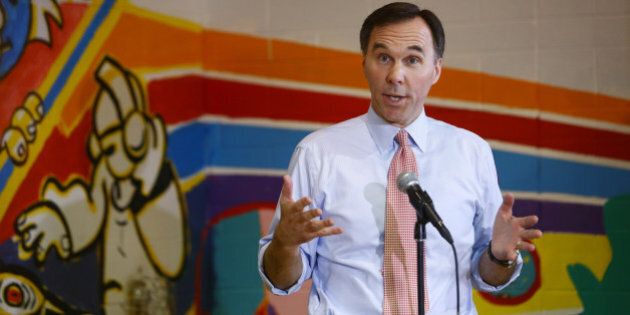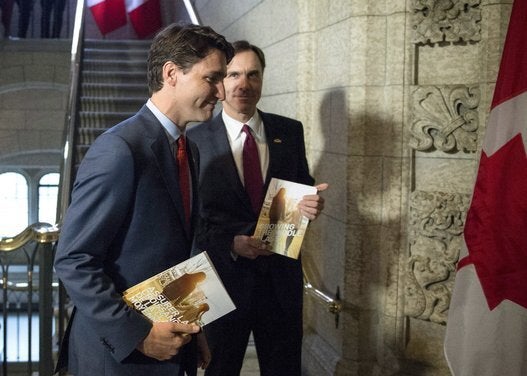
The proposed budget will increase government spending while having a deficit of $29.4 billion. It will direct billions of dollars to infrastructure spending, First Nations, and the middle class and lower income groups.
The budget is expected to be in deficit till 2020-21, when it is forecast to decrease to $14.3 billion. Even though it is predicted to be in deficit, the budget is geared towards helping the middle class as well as the lower income groups of society.
In the proposed budget, the current child benefit system would be replaced by Canada Child Benefit. The average benefit would be $2,300 in 2016-17. This new program would mostly benefit families with less than $30,000 in net income.
This program would cost $23 billion and nine out of 10 families would experience higher child benefits than under the current system. It is expected that 300,000 children will escape poverty in 2016-17 relative to 2014-15 due to this program.
Canada Child Benefit would definitely help low-income families including single-parent families and middle-class families.
The budget has increased Canada Student Grant by 50 per cent that would help students from low-income families, middle-income families as well as part-time students. Providing assistance of $1.53 billion over five years, this program would benefit 100,000 students from middle-class families, 247,000 students from low-income families and 16,000 part-time students.
This program would be very beneficial as it would help students to pursue education. Undoubtedly, it would improve human capital of the country by producing an educated and skilled workforce.
Again, increased investment in training as proposed in the budget would help the population to improve its skills. An educated and skilled workforce would translate into higher economic growth of the country.
The budget plans to invest more than $120 billion in infrastructure over ten years. It would invest in public transit, water and wastewater systems, creation of a low-carbon economy that would create jobs in the economy.
This will not only improve the economy but, connect and strengthen communities. Investments in green infrastructure is noteworthy especially when climate change is increasingly becoming an important issue to address.
Again, investments to create stronger communities and affordable housing would improve the quality of life of low-income people in the country while creating new jobs. Increased investments in affordable housing for low-income people and First Nations would benefit more than 100,000 households.
The budget proposed increasing affordable housing for seniors that would help low-income senior households. Supporting the construction of affordable housing, providing rent subsidies and programs to reduce homelessness would help those who need these services.
Investments in creating a more innovative economy would foster job creation and economic growth.
The proposed allocation of $8.4 billion over five years to First Nations is commendable as it would improve their socio-economic conditions and quality of life. Increased investments in education, infrastructure, etc. would improve First Nations' health and skills that would lead to better employment prospects for them.
The budget has proposed allocation of funds to support clean technology that will help in the transition of the economy to a low-carbon economy. Proposed allocations of almost $2.9 billion in the budget to address climate change and air pollution over five years are commendable. Decreases in air pollution would make air cleaner that would positively contribute to healthier Canadians.
Again, a healthy population would lead to decreases in health care costs. Programs to improve water quality of lakes would improve the quality of drinking water for Canadians. Overall, investments to reduce the impact of climate change and transition to a low-carbon economy would be helpful for both the health of Canadians and the economy in short to long-term.
Increases in Guaranteed Minimum Income by up to $947 annually would improve the financial security of 900,000 single seniors in the country. Enhancing the Canada Pension Plan, indexing seniors' benefits to their cost of living, supporting veterans and increasing the financial support for veterans are commendable as well as programs to strengthen Canada's health care system.
Investing to reduce tax evasion and combat tax avoidance are noteworthy as it leads to increased tax integrity, fairness of the tax system as well as higher government revenues. Again, measures to strengthen the financial sector to support economic growth are important in a world of uncertainty and risk.
The budget's proposal to introduce a "bail-in" regime which would emphasize that the bank shareholders and creditors would shoulder a bank's risks and failures, and not taxpayers is positive. The proposal allows the conversion of long-term debt of a troubled bank into common shares to recapitalize the bank, keeping it afloat and operating.
In line with international efforts to reduce potential risks to the financial system, this program would dampen the incentive for 'private profits and social losses', and the government's need to bail out "too big to fail" financial institutions.
The budget deficit is predicted to be $113.2 billion by 2020-21. Even though the budget would be in deficit, it is forecast that it would boost GDP by 0.5 per cent in the first year and by 1.0 per cent by the second year, leading to 100,000 jobs created by 2017-18.
These projections are dependent on domestic as well as international economic and political conditions. The budget is definitely ambitious and a deficit budget.
However, it is expected to help the low-income group and the middle class of the country.
The budget is investing in the people of Canada, particularly, the vulnerable members of the society and it is predicted to make meaningful impacts on the lives of Canadians while boosting economic growth of the country.
Follow HuffPost Canada Blogs on Facebook
MORE ON HUFFPOST:
